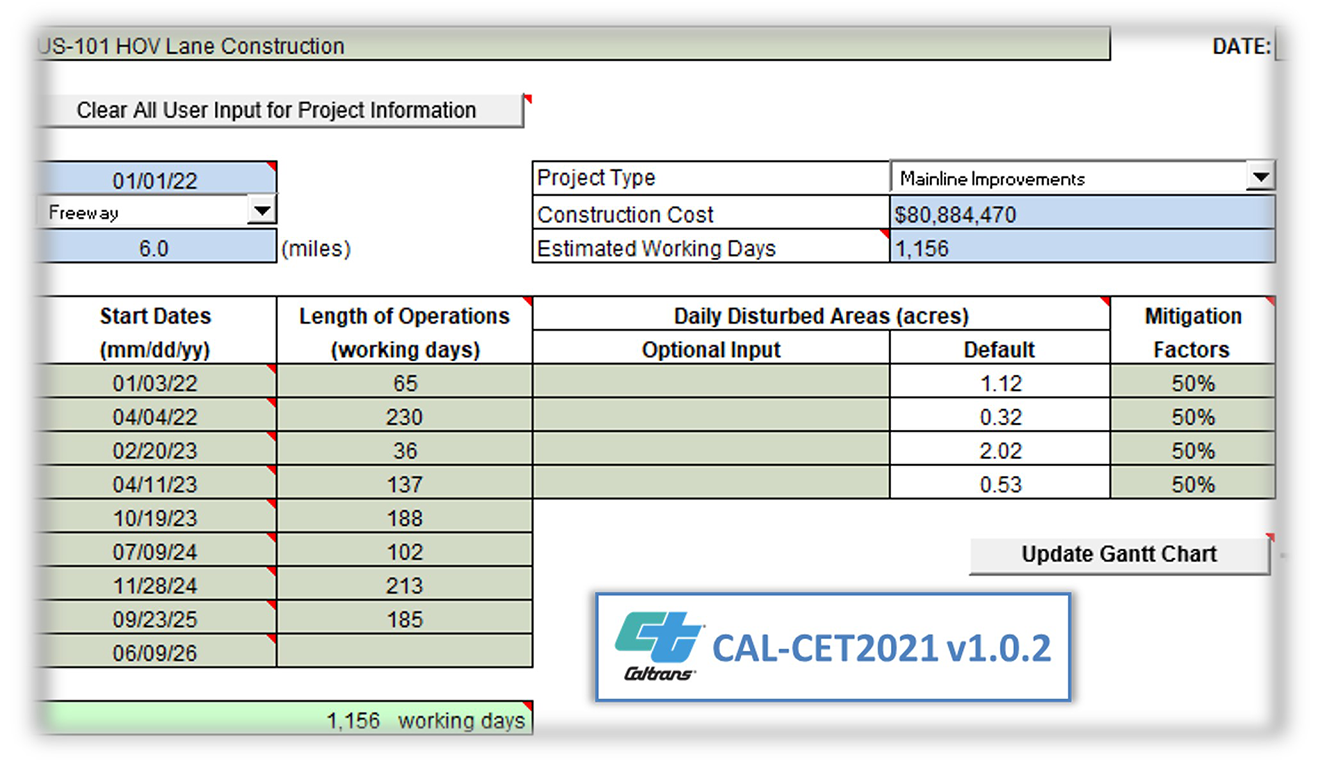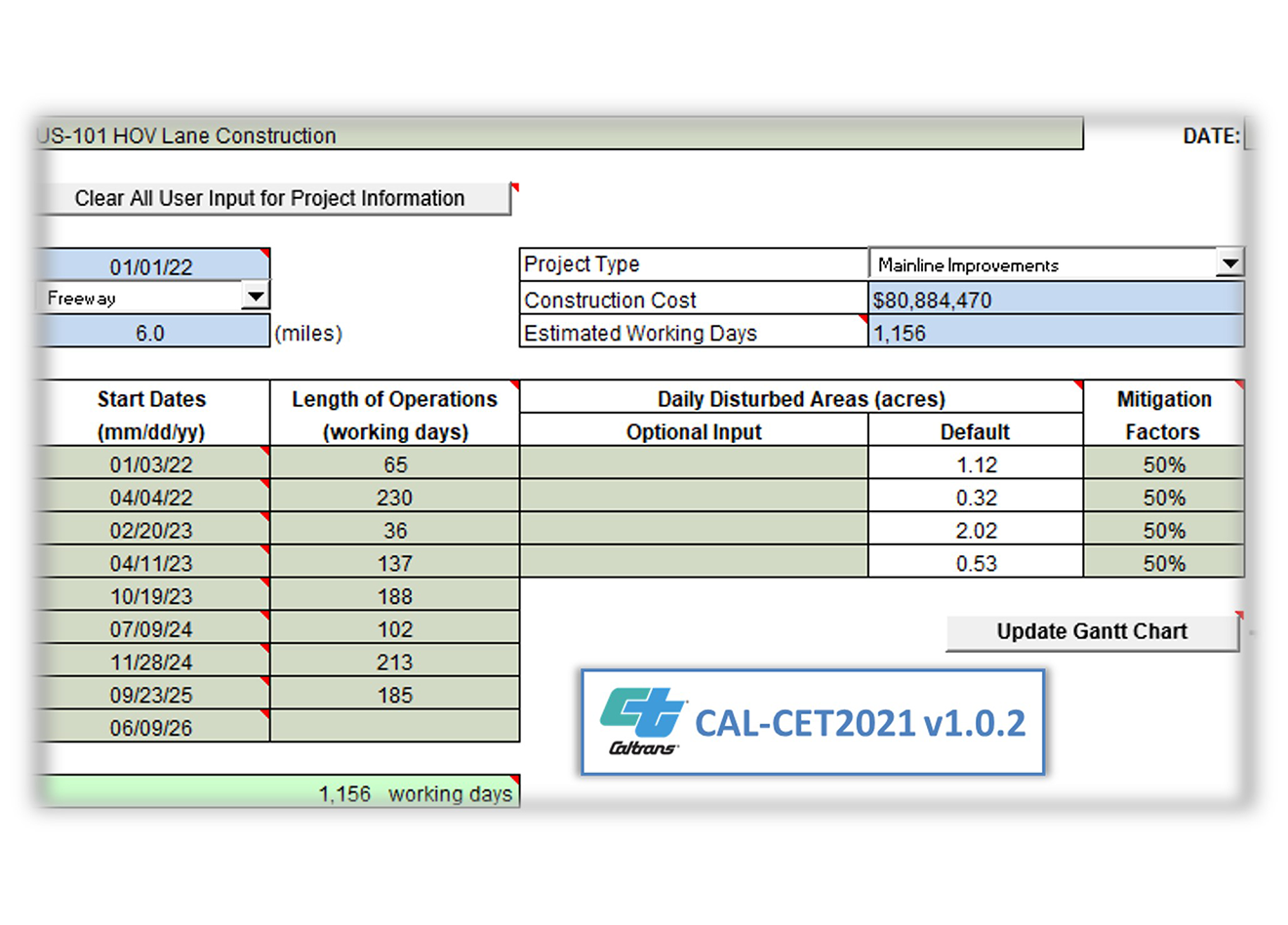CAL-CET Construction Emissions Modeling Tool: Estimating Off-Road Greenhouse Gases (GHGs), Air Toxics, and Criteria Pollutant Emissions
Clients
California Department of Transportation (Caltrans)
University of California Davis (U.C. Davis)
Sonoma Technology has worked for many years with the California Department of Transportation (Caltrans) to develop updated versions of the Caltrans Construction Emissions Tool (CAL-CET). CAL-CET helps analysts estimate pollutant emissions from construction work. CAL-CET updates expanded on prior work we completed in collaboration with faculty and researchers at U.C. Davis, including numerous tool development and analysis efforts to evaluate construction-related activities and emissions.
<br>
CAL-CET helps analysts assess roadway, bridge, and other transportation infrastructure improvements. Infrastructure construction and maintenance involves on- and off-road equipment such as diesel-powered backhoes, graders, and excavators. Such construction work emits fine (PM<sub>2.5</sub>) and coarse (PM<sub>10</sub>) particulate matter, oxides of nitrogen (NO<sub>x</sub>) that contribute to the formation of NO<sub>2</sub>, PM<sub>2.5</sub>, and ozone, and other pollutants such as greenhouse gases (GHGs). CAL-CET enables Caltrans staff to evaluate equipment fleet composition, activity, and fuel consumption to estimate emissions from construction work.
<br>
CAL-CET includes data from Caltrans, the California Air Resources Board (CARB), and other resources. For example, CAL-CET incorporates construction equipment activity; emissions and fuel consumption data from the CARB OFFROAD2017 v1.0.1 emissions inventory and methodology; on-road-truck activity, emissions, and fuel and electricity consumption data from the CARB EMFAC2021 v1.0.2 emissions inventory; Caltrans construction equipment rental rates and usage reports; default equipment load factors from the California Emissions Estimator Model (CalEEMod); and data from CARB’s GHG Inventory.
<br>
We also developed a CAL-CET “Best Practices” package using real-world example projects and feedback from Caltrans analysts. The Best Practices package provides quality assurance (QA) and quality control (QC) methods, and innovative approaches to apply CAL-CET in unique project situations.<br>
<br>
CAL-CET helps analysts assess roadway, bridge, and other transportation infrastructure improvements. Infrastructure construction and maintenance involves on- and off-road equipment such as diesel-powered backhoes, graders, and excavators. Such construction work emits fine (PM<sub>2.5</sub>) and coarse (PM<sub>10</sub>) particulate matter, oxides of nitrogen (NO<sub>x</sub>) that contribute to the formation of NO<sub>2</sub>, PM<sub>2.5</sub>, and ozone, and other pollutants such as greenhouse gases (GHGs). CAL-CET enables Caltrans staff to evaluate equipment fleet composition, activity, and fuel consumption to estimate emissions from construction work.
<br>
CAL-CET includes data from Caltrans, the California Air Resources Board (CARB), and other resources. For example, CAL-CET incorporates construction equipment activity; emissions and fuel consumption data from the CARB OFFROAD2017 v1.0.1 emissions inventory and methodology; on-road-truck activity, emissions, and fuel and electricity consumption data from the CARB EMFAC2021 v1.0.2 emissions inventory; Caltrans construction equipment rental rates and usage reports; default equipment load factors from the California Emissions Estimator Model (CalEEMod); and data from CARB’s GHG Inventory.
<br>
We also developed a CAL-CET “Best Practices” package using real-world example projects and feedback from Caltrans analysts. The Best Practices package provides quality assurance (QA) and quality control (QC) methods, and innovative approaches to apply CAL-CET in unique project situations.<br>
Air Quality
Climate
Data Management
Emissions
Modeling
Policy and Planning
Software Development
Transportation


Kenneth J. Craig

Kenneth
J.
Craig
Manager, Atmospheric and Emissions Modeling Group / Principal Scientist
kcraig@sonomatech.com
/sites/default/files/2023-02/KJCres.pdf
